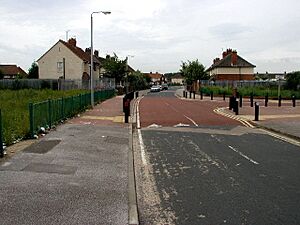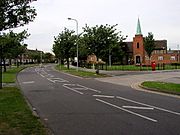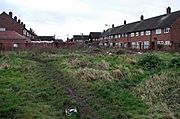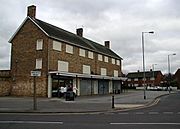Greatfield Estate, Kingston upon Hull facts for kids
Greatfield Estate is a friendly neighborhood located in the eastern part of Kingston upon Hull, East Riding of Yorkshire, England. It was built in the late 1950s to provide new homes for families.
Contents
Welcome to Greatfield Estate!
Where is Greatfield?
Greatfield Estate is in the far southeast of Kingston upon Hull. It's near the city's eastern edge, marked by the Old Fleet Drain. To the south, you'll find a path that used to be a railway line. Beyond that are industrial areas and the King George Dock. To the west is the Craven Park rugby ground and the Preston Road Estate. To the northwest is the Bilton Grange area. East of Greatfield, there's open farmland, with Preston about 4 miles away.
The land here is quite flat and low, less than 5 meters (about 16 feet) above sea level. Annandale Road is the main street in the estate. It curves through the area, connecting to Preston Road. Most people living in Greatfield are white British, making up about 93.1% of the population.
Building a Community: Greatfield's Story
Before Greatfield Estate was built, this area was mostly open fields. In the 1850s, it was just farmland with no roads. This stayed the same until the estate was constructed. The Hull and Holderness Railway, which now borders the estate to the south, was built in the early 1850s. Nearby, the Preston Road estate began to be developed in the 1930s. The Eastern Cemetery also opened nearby in 1931.
Homes and Design
After the Second World War, many homes in Hull needed to be rebuilt. So, the Hull Corporation (the local government at the time) decided to create several new housing areas in east Hull. These included Bilton Grange, Longhill, and Greatfield Estate.
Andrew Rankine, Hull's city architect, designed all these estates. He planned them as independent communities, each with its own shops, schools, libraries, and other important facilities. The buildings were made of brick with special curved roof tiles, similar to the "Festival of Britain" style. The roads were often short and curvy, and there were lots of open, green spaces with trees. Greatfield Estate itself was built with 823 houses.
The goal was to create a friendly community where everyone felt like they belonged, almost like a small village. The estate was finished in 1960.
Schools and Learning
When Greatfield was built, many children needed schools because of the "baby boom" after the war. For younger kids, there were Ashwell Infants School and Ashwell Junior School, as well as Oldfleet Infants School and Stockwell Infants School.
Over the years, the way schools were organized changed. In 1969, Ashwell Schools became a Junior High School for ages 9–13. Later, as the number of children in the area changed, Ashwell Junior High School closed in 2009. Stockwell and Oldfleet Infants Schools became County Primary Schools, teaching children from ages 5–13.
Greatfield Senior High School opened in 1957. It was a large school with three parts: Newton Hall (for technical skills), Elizabethan Hall (a secondary modern school), and Shakespeare Hall (a grammar school). These schools were all next to each other. In 1969, the schools changed again. Newton and Elizabethan Hall became one Senior High School for ages 13–16, and Shakespeare Hall became a new Junior High School for ages 9–13.
Shakespeare Junior High School closed in 1988 and was later taken down. A new supermarket was built on its site. The current Craven Park rugby ground was built on the school's old playing fields in the late 1980s. The main Greatfield Senior High School buildings were also taken down in the early 2010s, but the gym was kept for the community. In 2014, a new school called "Aspire Academy" started being built on the old Isaac Newton school site, opening in 2015.
Community Places
The estate also had three local pubs where people could meet: The Lord Charles, The Falcon, and The Goat and Compasses. Even though the area faced some challenges in the late 1900s, people say that Greatfield has always had a very strong community spirit.
In 2015, the community organized special events to celebrate Greatfield Estate being 60 years old!
Famous Faces from Greatfield
Some well-known people have lived in Greatfield Estate:
- Mick Ronson: A famous musician. A road nearby is even named 'Ronson Close' in his honor.
- Lene Lovich: A singer who lived on the estate when she was a teenager.
- Paul Spencer Denman: Another musician who grew up in Greatfield.
Gallery






